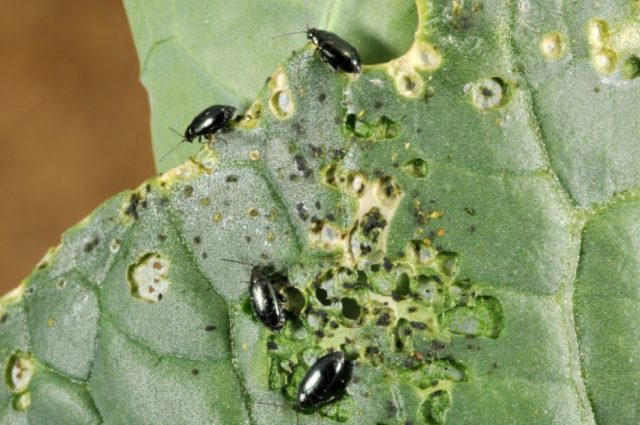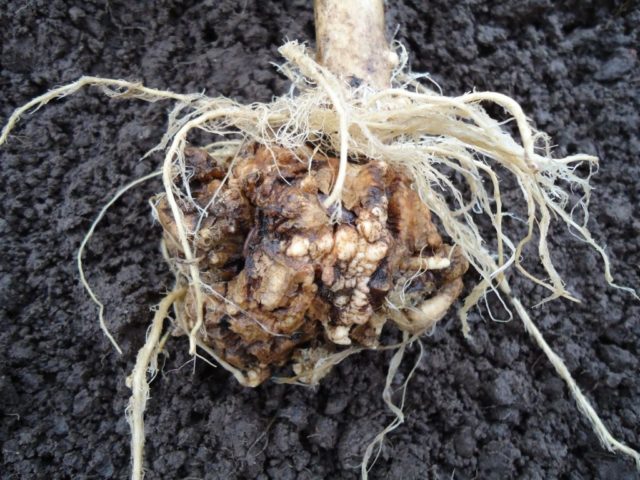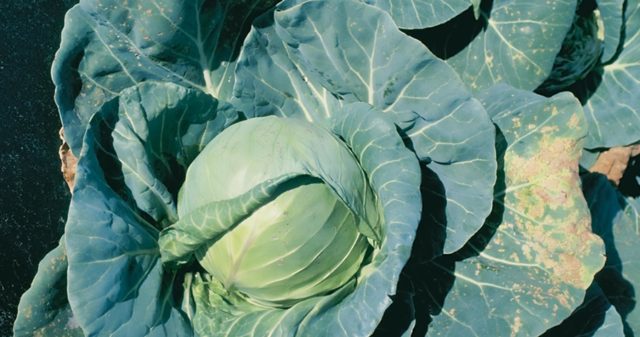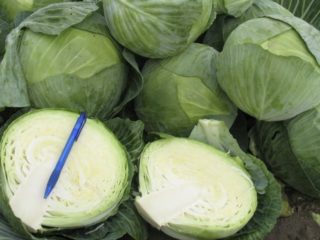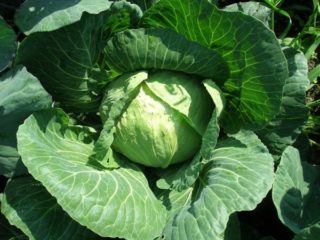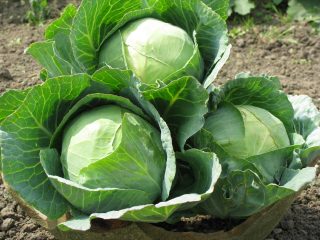Content
Larsia cabbage was bred for the purpose of commercial cultivation. Scientists have tried to create a variety that is maximally protected from pests and adverse weather conditions. In addition to stability, the heads of cabbage are characterized by excellent taste, large size and small stump.
Description of Larsia cabbage
Breeders from the American community Seminis Vegetable Seeds, Inc. The Larsia F1 cabbage variety was introduced in 2005. It entered the state register of Russia as an industrial and commercial type. Suitable for growing in the middle lane.
Mid-season variety, ripening occurs 130-140 days after planting. Heads of cabbage in the cut are white with a green tint. The leaves have a slight waxy coating of gray-green color. The sizes of heads of cabbage reach from 4 to 6 kg, the maximum weight is 8 kg. Wide rosettes, sprawling foliage. It takes root well in the open field.
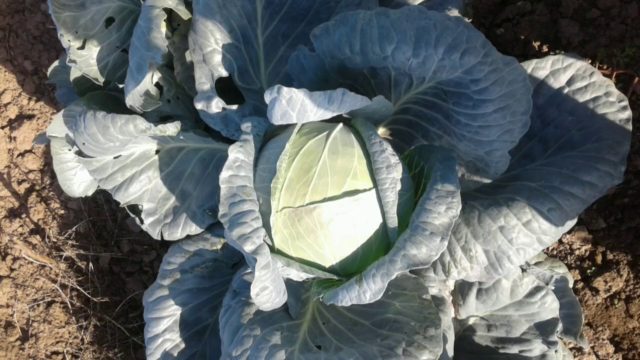
The leaves of the Larsia variety have a gray-green color due to a waxy bloom
Larsia cabbage is high-yielding. Taste qualities according to the assessment of tasters 4.4 out of 5 possible points are characterized as good.
Features of the variety:
View | White cabbage |
Kochan | Rounded, dense, short stump |
Fruit weight | 4-8 kg |
Landing | 70 × 70 cm between sockets |
Maturation | 125-140 days, mid-season |
Place of growth | Open ground |
Using | Universal |
Diseases | Fusarium and thrips resistance |
The heads of Larsia are very dense, all the leaves are adjacent to each other.
Advantages and disadvantages
Larsia cabbage has its own advantages and disadvantages. The positive aspects include:
- high productivity;
- excellent taste;
- versatility in use;
- the vegetable can be cut before full ripening for summer salad;
- transportability;
- good presentation;
- short stump;
- the possibility of growing in the open field;
- heads do not crack;
- there is immunity to fusarium;
- thrips resistance.
Of the negative points, we can note the short storage of the crop - only for 4 months. Also, this variety is not intended for greenhouse cultivation.
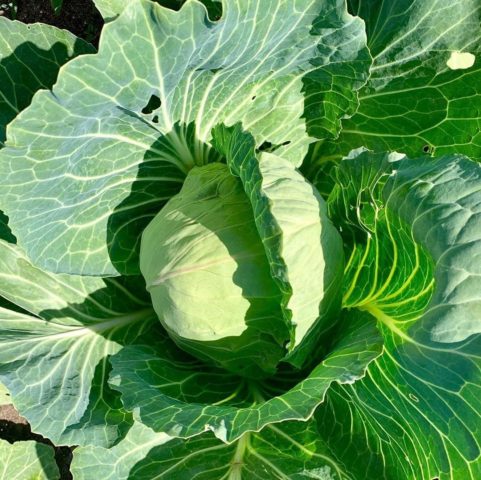
The heads of cabbage of the Larsia variety are large, the leaves fit tightly to each other
Cabbage yield Larsia F1
The yield from Larsia cabbage is up to 55 tons per hectare of area. Such an indicator is considered high, therefore this vegetable variety is grown for commercial activities. The maximum yield was observed in the Smolensk region - from 1 hectare of land 76 tons of crop. 28,000 plants are planted per hectare of land.

All heads of Larsia cabbage are even, large ones tolerate transportation well
Planting and caring for Larsia cabbage
The principle of caring for and planting Larsia is the same as for other types of cabbage. All work begins with the preparation and purchase of seeds.
Selection and preparation of seeds
Cabbage grains are sold in specialized agricultural technology stores. Breeders provide quality seeds for sale. It is advisable not to buy them from your hands, there is a high probability of deception. They are usually sold ready to plant.
The preparation procedure can be carried out independently:
- Make a saline solution from 10 g of salt in 1 glass of water. Dip seeds into it.Some of them will emerge, this suggests that they will not sprout.
- They take out the grains, blot with gauze.
- Prepare a solution of potassium permanganate, soak the seeds for 1 hour.
- It is dried, placed in damp gauze and left in the refrigerator on the lower shelf for 2 days.
Meanwhile, the container and soil are being prepared. The soil mixture can be made independently from the following components:
- 1 part of humus;
- 1 part of sod land;
- 1 kg of soil;
- 1 tbsp. l. ash.
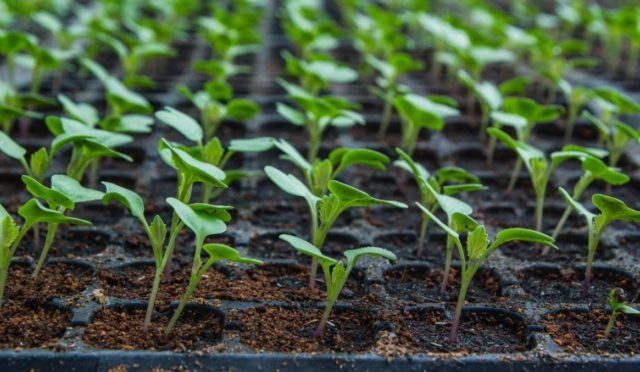
Each sprout should have a separate hole so that the roots do not intertwine
All components are mixed together and calcined in the oven at 180 0C for 20 minutes. Some gardeners use special peat boxes. Once transferred to the ground, they disintegrate and fertilize the plants.
Suitable containers:
- plastic cups;
- cardboard boxes;
- peat bolls;
- small bottles cut in half.
The preparation of seedlings begins at the end of March. After sprouting, transfer to open ground is possible after the cabbage has 2 true leaves.
Site preparation
Cabbage prefers well-lit, level land. It is advisable to grow the vegetable on loamy soils with a slightly acidic or neutral environment. It is forbidden to sow cabbage in places where cruciferous plants previously grew, they have the same diseases, then the risk of infection increases.
Garden bed preparation:
- In early spring or late autumn, a plot of land is dug up.
- Remove all stones and roots from plants.
- Fertilizers are added.
The more fertile the soil, the higher the yield. For cabbage, add to the soil:
- humus;
- wood ash;
- nitrophoska solution 10%.
Work is carried out 1 month before planting, so that all fertilizing can be absorbed.
Landing
For 10-12 days, the seedlings begin to prepare for transfer to open ground. It is necessary to harden the plants. For this, the room is regularly ventilated for 3-4 hours. Every day, seedlings are taken out on the balcony in the sun. The first day for 30 minutes, the second for 40 minutes. Gradually increase the time to 1-2 hours a day. So the sprouts will get used to the direct sun.
Algorithm for transfer to soil:
- Dig holes in the garden bed 15 cm deep.
- Adhere to the scheme 70 × 70 cm.
- Moisten the hole with warm water.
- Seedlings dive.
- Close up to the base of the first leaves.
If there is no rain, the seedlings are watered on the same day, the work is carried out in the morning.
Watering
Good and timely irrigation will contribute to the formation of large heads of cabbage. For the first 14 days, the plants are watered every 4 days, consuming 8 liters of water per 1 m2... Further, irrigation is carried out once a week, up to 10 liters per 1 m2.
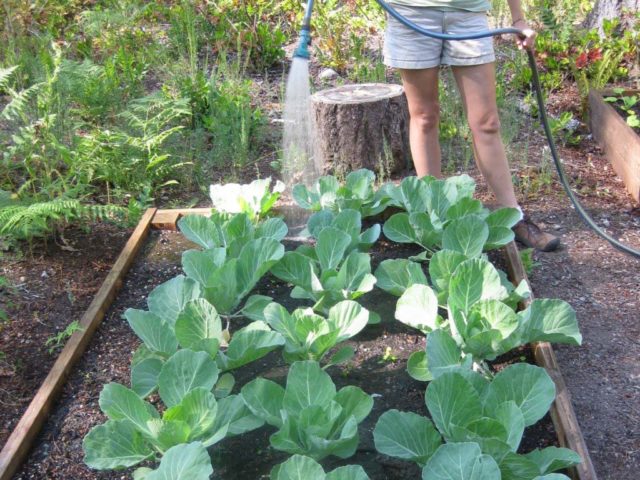
Periodic sprinkling of plantings will help plants survive the heat.
Top dressing
To get a decent harvest, the plant needs additional nutrition:
- On the 14th day after transfer to the ground, the planting is fertilized with a mullein solution.
- Repeat the same feed after another 2 weeks.
- 6 weeks after planting, they are fed with a mixture of mullein and superphosphate.
- At the age of two months, a mixture of mullein and superphosphate is added again.
The first top dressing can be skipped if fertilizer has been added to the seed boxes.
Loosening and weeding
These are two mandatory procedures. Weeds are removed as they grow. If this is not done, then they will begin to feed on useful minerals from the soil, they will not be enough for cabbage. Loosening the soil helps additional roots to form. Both manipulations can be combined.
Hilling is carried out 25 days after planting. This will improve the health of the seedlings and help them retain moisture longer in hot weather.
Diseases and pests
The Larsia variety is resistant to many bacterial diseases. It is rarely affected by caterpillars. Most often this happens due to improper observance of the rules of agricultural technology.
Possible pests and diseases:
- Cruciferous flea. Small black insects feed on cabbage leaf juice. Plants are treated with an insecticide.
Beetles eat holes in leaves and disrupt their nutrition
- Keela. Fungal disease affects the root system of vegetables, which is why nutrition is disturbed. Bordeaux mixture of 3% is used to fight.
Keel spores are in the soil, so the plants become infected
- Downy mildew. A white bloom forms on the underside of the leaf. Gradually, the foliage turns yellow and dries. Landings are treated with Bordeaux mixture 1%.
Downy mildew slowly kills cabbage plantings
In order not to face diseases, on the 14th day, the seedlings are treated with copper sulfate. Sprinkle the plants and the garden with the agent.
The use of white cabbage Larsia
The use of cabbage is varied. White-headed varieties are used to make preparations for the winter, various dishes and salads are prepared. Heads of cabbage are stored for the winter and used until the beginning of the next season.
The Larsia variety is used to prepare:
- stewed cabbage;
- vegetable salads;
- cabbage rolls;
- soups;
- canned with other vegetables.
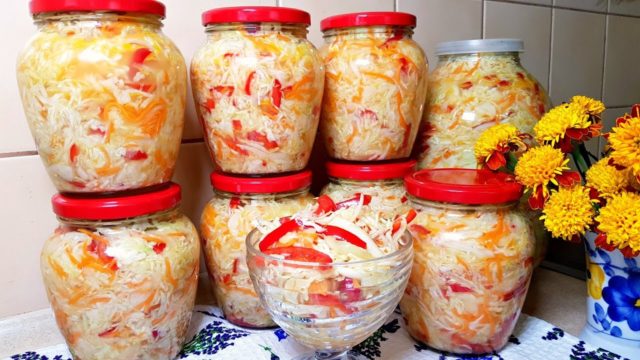
It is especially tasty to prepare salads from Larsia for the winter, the cabbage remains crispy even after sterilization
Conclusion
Larsia cabbage is great for growing in your own gardens and on an industrial scale. It has good resistance to adverse weather conditions, diseases and pests. The yield is high, which allows you to enjoy the vegetable all summer and leave some for the winter.
